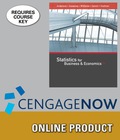
Concept explainers
In baseball, an earned run is any run that the opposing team scores off the pitcher except for runs scored as a result of errors. The earned run average (ERA), the statistic most often used to compare the performance of pitchers, is computed as follows:
Note that the average number of earned runs per inning pitched is multiplied by nine, the number of innings in a regulation game. Thus, ERA represents the average number of runs the pitcher gives up per nine innings. For instance, in 2008, Roy Halladay, a pitcher for the Toronto Blue Jays, pitched 246 innings and gave up 76 earned runs; his ERA was (76/246)9 = 2.78. To investigate the relationship between ERA and other measures of pitching performance, data for 50 Major League Baseball pitchers for the 2008 season appear in the data set named MLBPitching (MLB website, February 2009). Descriptions for variables which appear on the data set follow:
| W | Number of games won |
| L | Number of games lost |
| WPCT | Percentage of games won |
| H/9 | Average number of hits given up per nine innings |
| HR/9 | Average number of home runs given up per nine innings |
| BB/9 | Average number of bases on balls given up per nine innings |
- a. Develop an estimated regression equation that can be used to predict the earned run average given the average number hits given up per nine innings.
- b. Develop an estimated regression equation that can be used to predict the earned run average given the average number hits given up per nine innings, the average number of home runs given up per nine innings, and the average number of bases on balls given up per nine innings.
- c. At the .05 level of significance, test whether the two independent variables added in part (b), the average number of home runs given up per nine innings and the average number of bases on ball given up per nine innings, contribute significantly to the estimated regression equation developed in part (a).
Trending nowThis is a popular solution!

Chapter 16 Solutions
CENGAGENOW FOR ANDERSON/SWEENEY/WILLIAM
- 19. Let X be a non-negative random variable. Show that lim nE (IX >n)) = 0. E lim (x)-0. = >arrow_forward(c) Utilize Fubini's Theorem to demonstrate that E(X)= = (1- F(x))dx.arrow_forward(c) Describe the positive and negative parts of a random variable. How is the integral defined for a general random variable using these components?arrow_forward
- 26. (a) Provide an example where X, X but E(X,) does not converge to E(X).arrow_forward(b) Demonstrate that if X and Y are independent, then it follows that E(XY) E(X)E(Y);arrow_forward(d) Under what conditions do we say that a random variable X is integrable, specifically when (i) X is a non-negative random variable and (ii) when X is a general random variable?arrow_forward
 Holt Mcdougal Larson Pre-algebra: Student Edition...AlgebraISBN:9780547587776Author:HOLT MCDOUGALPublisher:HOLT MCDOUGAL
Holt Mcdougal Larson Pre-algebra: Student Edition...AlgebraISBN:9780547587776Author:HOLT MCDOUGALPublisher:HOLT MCDOUGAL College Algebra (MindTap Course List)AlgebraISBN:9781305652231Author:R. David Gustafson, Jeff HughesPublisher:Cengage Learning
College Algebra (MindTap Course List)AlgebraISBN:9781305652231Author:R. David Gustafson, Jeff HughesPublisher:Cengage Learning Algebra: Structure And Method, Book 1AlgebraISBN:9780395977224Author:Richard G. Brown, Mary P. Dolciani, Robert H. Sorgenfrey, William L. ColePublisher:McDougal Littell
Algebra: Structure And Method, Book 1AlgebraISBN:9780395977224Author:Richard G. Brown, Mary P. Dolciani, Robert H. Sorgenfrey, William L. ColePublisher:McDougal Littell Glencoe Algebra 1, Student Edition, 9780079039897...AlgebraISBN:9780079039897Author:CarterPublisher:McGraw Hill
Glencoe Algebra 1, Student Edition, 9780079039897...AlgebraISBN:9780079039897Author:CarterPublisher:McGraw Hill Functions and Change: A Modeling Approach to Coll...AlgebraISBN:9781337111348Author:Bruce Crauder, Benny Evans, Alan NoellPublisher:Cengage Learning
Functions and Change: A Modeling Approach to Coll...AlgebraISBN:9781337111348Author:Bruce Crauder, Benny Evans, Alan NoellPublisher:Cengage Learning Big Ideas Math A Bridge To Success Algebra 1: Stu...AlgebraISBN:9781680331141Author:HOUGHTON MIFFLIN HARCOURTPublisher:Houghton Mifflin Harcourt
Big Ideas Math A Bridge To Success Algebra 1: Stu...AlgebraISBN:9781680331141Author:HOUGHTON MIFFLIN HARCOURTPublisher:Houghton Mifflin Harcourt





